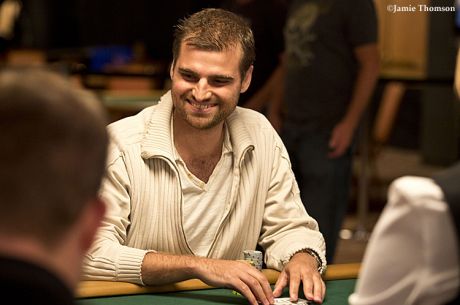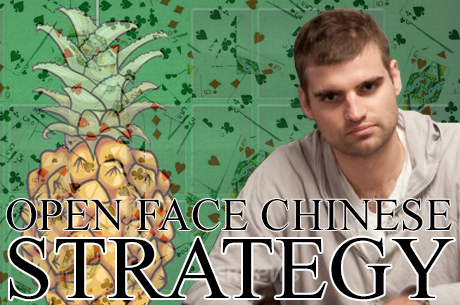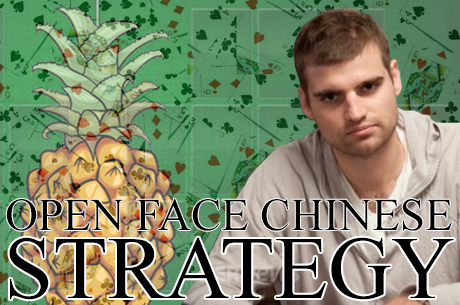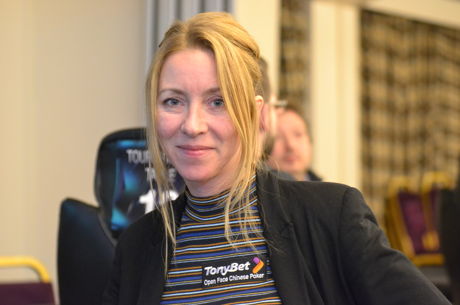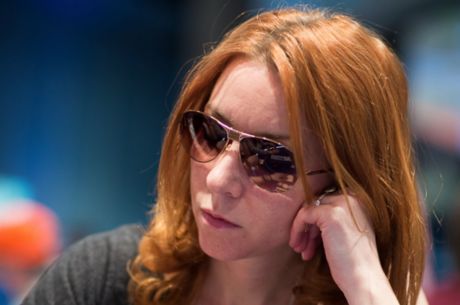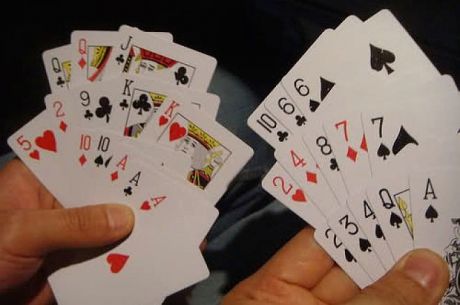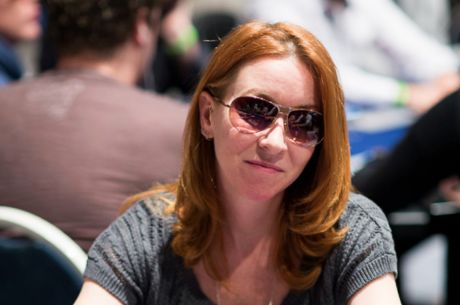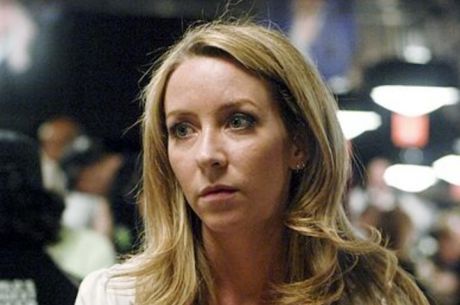Nikolai Yakovenko on the State of Open-Face Chinese Poker, Part II

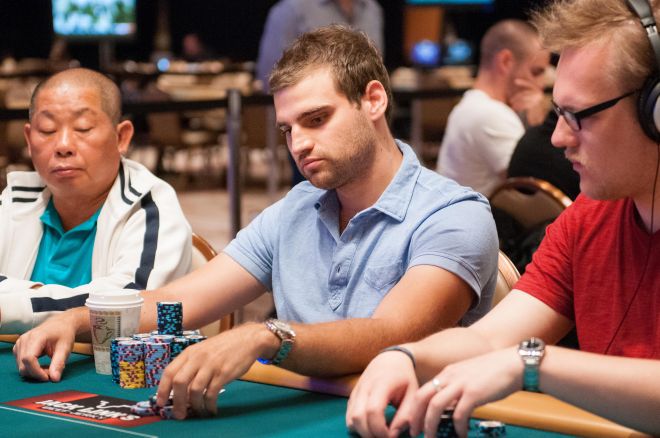
Nikolai Yakovenko helped create the popular ABC Open-Face Chinese Poker iPhone app which has become a favorite of many OFC players.
Yesterday, Yakovenko offered his expert opinion on the current state of OFC. Today he delves deeper into the current state of OFC with a hypothetical Q&A.
Q: Is Open-Face solved? Can’t a computer play it perfectly?
No. Every position is unique, and the search space grows exponentially, like in chess. This means that even with very fast computers, you can’t write a program to play the game very well without lots of specialized software to estimate values and approximate ranges — all of the same stuff you’d need to build for a strong poker-playing bot. And that software would have to be written from scratch. As far as anybody I’ve spoke to knows, it hasn’t been written or even seriously attempted.
Q: So then what kinds of long-term edges exist in OFC Pineapple?
I expect that someone playing perfect Open-Face Pineapple (not knowing what’s coming, but playing perfectly based on the cards seen so far) could have an edge as big as a point, or even a point-and-a-half per round, against today’s best players. Especially if that perfect player (or computer) could see his opponents’ discards.
Of course, seeing your opponents’ discards is not part of the game, but they say that Stu Ungar was so good at gin that he could tell you his opponent’s hand, usually card-for-card, by the middle of the game. The same could be possible for OFC hands, and indeed good players use the fact that an opponent could never discard a specific card to their advantage. I don’t know of any computer that does this well. The computer AI that comes with my ABC Open-Face app uses doesn’t even attempt to guess possible discards, but the best Pineapple players do it all the time.
As an extension of this computer AI we’ve also developed a simulator, which given enough time runs two moves in the same position 10,000 times to the end of the hand, determining which move is better and by how many points. This process takes hours — sometimes days — and it’s not accurate for small differences in value. But it’s good for determining value differences of a point or more.
The point is, we’ve used this simulator to figure out the “right move” in tricky spots, often with strong OFC players suggesting a position, or pitching in opinions on both sides. Most of the time, the strong players agree on the best move, but not always. And when they disagree, the simulator often shows the differences in value to be a point or more. Even accounting for the error in simulator results, it’s not uncommon or very strong OFC players to disagree in spots where the difference in the move values is a point or more.
And why wouldn’t that be the case? I’m actually amazed how often the strong OFC players agree on the best move in complicated spots. In these cases, the simulator always confirms that they are right. This is remarkable since none of the players has access to a powerful computer, a strategy book, or any other reference for making their decision.
The game is complicated — really complicated — and the swings are huge. But behind those swings there is significant room to outplay your opponents, at least in the long run.
Q: You lost me there. I’m much better at OFC than my buddy Gus, but I’m on a 200-point downswing against him. Is this normal?
Yes. To put it into perspective, the normal variance of one Pineapple OFC hand is about +/-18 points (one standard deviation, for you statistics majors). The way these things work, in a 100-hand match you’d expect the normal variance of that match to be about 180 points. Let’s call it 200.
This means that when two equally skilled opponents face off, two-thirds of the time one of them will win by no more than 200 points. This is the normal range.
Even if you are much better than Gus with a half-point per round long-run edge (and that’s a big edge), it’s normal for you to lose a 100-hand match to him. In fact, a half-point edge per hand will only mean that you are winning two-thirds or so of the 100-hand matches against Gus in the long run.
Remember, Open-Face is half-poker, half-blackjack, and as any sports fan knows, if you focus on a winning streak or a losing streak, as opposed to the full season, it’s possible to find even bigger swings than normal. So Gus beating you by 200 points means nothing, but if Gus were beating you for 800 points straight, now that would be meaningful.
Q: Is OFC a fad? I know some people have been playing 1,000-hand matches against each other, but won’t everyone get bored with Pineapple after a while?
Maybe. But this game has been around for almost three years now, and its popularity is still growing. Pineapple OFC has been out there almost as long as the regular variety. It just didn’t become the more popular variant until last year’s World Series.
There may be a new popular game around the corner, but it will take time for it to emerge, as Open-Face has. Provided, of course, that one considers a year or two to be a long time.
It’s not that easy to come up with a card game that is both as simple and yet as complex and addictive as Open-Face Chinese. Many have tried, and OFC, like blackjack, hold’em, and every other great card game, has no author. It emerged several years ago from a series of small tweaks to games that have existed in the public domain for decades.
For whatever reason, OFC hit a nerve with today’s poker players, and that community continues to grow. Eventually times will change, and new card games will become popular, but OFC is here to stay. I would bet that it has not yet reached its full potential.
Q: Where can I learn more about Open-Face?
There aren’t any books on OFC, and as far as I know nothing like the high-quality, high-volume poker discussion forums, like Two Plus Two, circa 2005-2008.
Q: So there are no books, and not a whole lot on the forums. Where do people talk about OFC, then?
On Twitter, mostly — like many things poker these days. I won’t list them here, but OFC hands posted by poker pros aren’t hard to find.
Q: These guys are posting bad beats and suck outs. I’d like to improve my OFC Pineapple game. How could I go about doing so?
I’d start by playing against the computer AI, included with the latest release of my ABC Open-Face Chinese app. It doesn’t play perfectly, but we’ve coached it up to play at the level of a pretty good human player, and an aggressive one at that. There’s nothing like getting a bunch of hands in against pretty good competition to get an intuition for what kind of moves to look for.
Some of the best OFC players that I know seem always to make the right choice in tough spots, but can never explain why they make those moves. You can only develop that kind of intuition by playing. And if you’re not sure, always go with the more aggressive move. If it’s close, gamble, especially early in the hand. Start each round trying to make a big hand. It’s okay to foul a lot of hands, as the bigger hands you make when you get lucky will more than compensate for the fixed downside of fouling.
There you have it. There's your OFC Pineapple Super/System right there.
Q: That’s fine. But what about some real OFC Pineapple strategy advice?
Here’s a few OFC Pineapple-related themes we’ve been kicking around on Twitter:
1. (Almost) always go for Fantasyland. Especially early in the hand.
This would be my No. 1 advice for most intermediate players. If you get dealt two queens in your starting hand, there’s nothing wrong with putting those queens on top. It won’t always be the best move, but that should be your baseline. You need a good reason to play a different move. Burden of proof is on the less aggressive move.
Anything that helps you get to Fantasyland should be your default play. This means that a pair of aces belongs in the middle, a pair of queens on top, and a lone ace, king, or queen usually belongs on top as well. Small pairs go in the middle. Bigger pairs go in the back, unless you have a good chance for a straight or a flush on the bottom.
For example, in Pineapple, this kind of play is automatic:
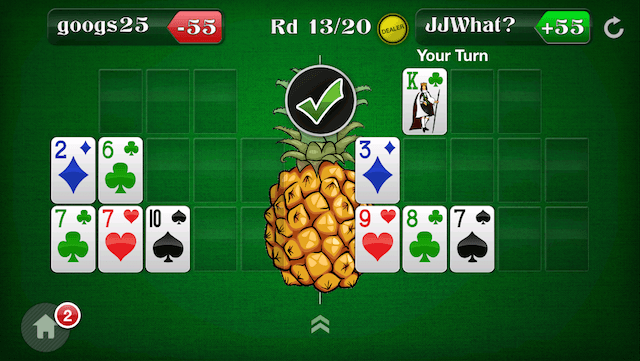
Early in the hand, if there is a direct path to Fantasyland, then that’s how I set my hand. In this case, the easiest way to Fantasyland is to make a straight on the bottom, two pair or trips (or aces) in the middle, and kings on top. So that’s what I aim for.
2. Later in the hand, if it seems close… gamble!
Rare case where probably not worth it to gamble. http://t.co/zbm5MgTFHz
— Nikolai Yakovenko (@ivan_bezdomny)
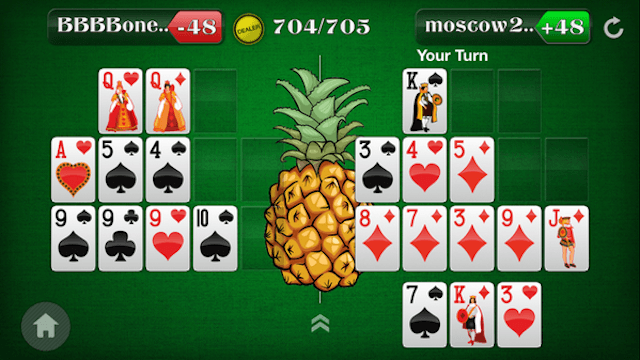
It’s a pretty aggressive gamble to pair the king up top and to put the 7♠ in the middle. I'll need a six and a six only not to foul my hand. Moreover, my opponent has played aggressively himself, and there is a very good chance that he’s fouling. So I wussed out and didn’t pair the king on top. Besides I thought, if I do make my middle, I can catch another king and still go to Fantasyland.
Wrong.
All of the strong OFC players who chimed in on Twitter chastised me for not playing for the maximum possible hand. And the simulator proved them right. Playing passively here is a full two-point mistake. That’s even with my opponent likely fouling, my hand winning the bottom, and with an opportunity to freeroll the last round if I choose not to gamble.
It’s not always right to take on more risk for a big hand. But it’s usually right, and if you think it’s close, oftentimes it isn’t.
3. A four-card flush on the bottom is a very good hand. A three-card flush is nothing special.
This is what’s called an inflection point. A four-card flush on the bottom, especially early, is almost as good as a made flush. In some cases, it’s even better.
If you have a four-flush on the bottom, it’s okay to leave it four-flush and use you move to improve another row instead. For example, pair the middle or put a live king up top, and definitely play that third card for the open-ended straight in the middle. All of those are usually more useful than filling your bottom flush right away.
Intuitively, this makes sense. If there are six or seven diamonds left for your flush, and you are drawing six or nine more cards — two or three more Pineapple rounds — your chance of getting another diamond is very high, well over 80% in fact. Your middle and top hands often need to improve more urgently, and if you don’t pair that middle card now, there are only two more cards in the deck, or none at all, that will make you that pair. Another diamond will almost certainly come.
However, a three-card flush on the bottom — well, that can go either way. Even with seven or eight diamonds live and with nine more cards coming — three more Pineapple rounds — your odds to make the three-flush don’t drop from 85% to 75%, they’re down to about 50/50. Which also makes sense. Hitting a diamond twice isn’t just twice as hard as hitting a diamond once. It’s much harder. You’re in a runner-runner type situation.
Since you often need that flush on the bottom to not foul your hand, making the fourth diamond on the bottom is critical, and it should be automatic. I make that fourth diamond over pairing the middle, and over putting a live ace, king, or queen up top.
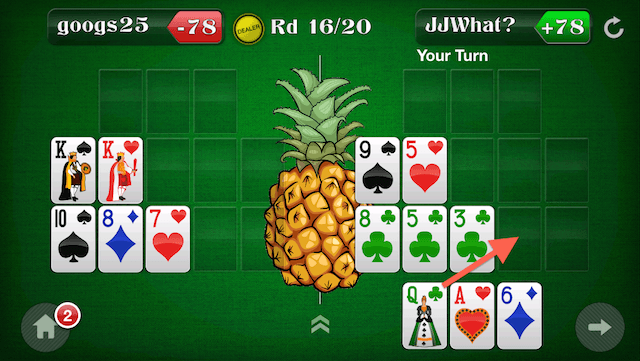
Bonus points for guessing which second card to play and where.
Since a three-flush on the bottom is a vulnerable hand until it becomes a four-flush, it also follows that you should not always be aggressive in playing a three-flush there in the first place. With two cards on the bottom you can always pivot toward a full house, a straight, or go for a live two pair. Once you play the third diamond, you’re going pretty committed to a flush, yet often it’s just 50/50 or so to get there.
So keep that in mind. Always make the four-flush if you can — it’s almost as good as a made flush. But don’t be in a rush to make a three-flush, especially if you have better options. Definitely don’t break up a pair like aces, kings, or queens to make a three-flush on the bottom.
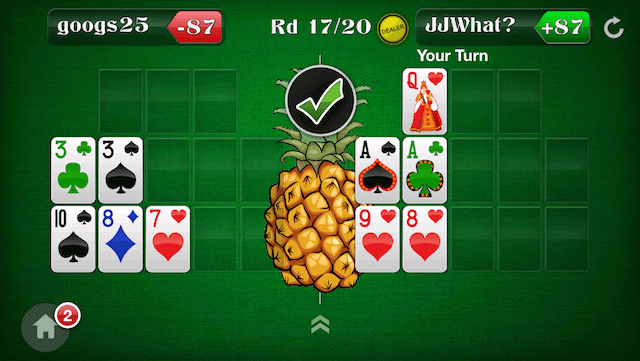
4. Don’t worry about how big your opponent’s house is.
Poker players aren’t known as the world's most empathetic people, and yet we spend a lot of time at the tables saying things like “Does he have it?” And “Surely, he’s never bluffing here.” And “Don’t call me Shirley!” (Rim shot.)
But in OFC Pineapple, your opponent’s hand usually doesn’t have much effect on your best move, and in fact you can usually move on autopilot without considering what your opponent is going to make.
Of course, you should definitely look at what cards your opponent has played, since those cards are now dead and significantly affect your odds of making pairs, straights, and flushes. But whether your opponent has a good hand, a bad hand, is likely scooping you, or is fouling against you, it just doesn’t matter very much.
I know this because the computer AI in my ABC Open-Face app plays pretty well and pays almost no attention to the hand it’s up against. Of course, it counts the dead cards and it’s aware of how likely its opponent is to foul, but that’s about it.
When I was tuning up the AI since the last app update, I improved its logic in several ways. It estimates its own foul risk better, it handles trips much better, and it has a better understanding of flush draws. Taking better account of its opponent’s hand was on the list, but that kept getting pushed down. After a few months, the AI played dramatically better, and I never built a system for it to adjust against the opponent’s range.
You’d think that there would be many cases where where the AI misplays its kickers, makes two pair in the middle when one pair is good enough, or worries about making a small pair on top when its opponent can’t beat ace-high anyway. But in practice this almost never matters.
Your purpose, at least in OFC Pineapple (regular OFC is different), is to make the best possible hand from the cards that you are dealt. As part of this, you should be aware of what potential hands are live, and which ones are dead. If your opponent is going to scoop you regardless, feel free to go for a super-longshot, and if he’s 90% fouling of the time, vice-versa.
But if your opponent is playing solid OFC, he or she will usually have a dynamic hand that can go either way. You'll also have a dynamic hand that can go either way, so just play to maximize your hand.
Consider the example above. I backed off of pairing the king up top because my opponent was likely to foul, and I can win a tidy +10 if he does. Well, it was the wrong move. The fact that he is often fouling has a large effect on the value of my hand, but it has very little effect on choosing correctly between move A and move B. Both move A and move B are up against the same hand.
It’s like in the NFL, or in Major League Baseball. You’re up at bat, or the QB under center. Your goal, 95% of the time, is to make the best play: to get on base, or to get the next first down. This doesn’t change much, no matter what the other team is doing. Unless you’re in the fourth quarter and down two scores, your job is simply to advance down the field, to do what your offense is best at, and to take what the defense is giving you.
Just play the best move, be aggressive when you can be, and don’t worry what you could have won when your opponent fouls. Playing perfect OFC Pineapple is impossible, but playing a pretty solid game really isn’t all that hard.
Thank you for reading. Good luck in your games, and if interesting spots come up, post them on social media. Let’s get more OFC discussions going.
P.S. For the four-flush hand, the best move is Q♣ bottom, and A♥ on top! Six-middle instead is a good move also. Other moves are at least 1.5 points worse.
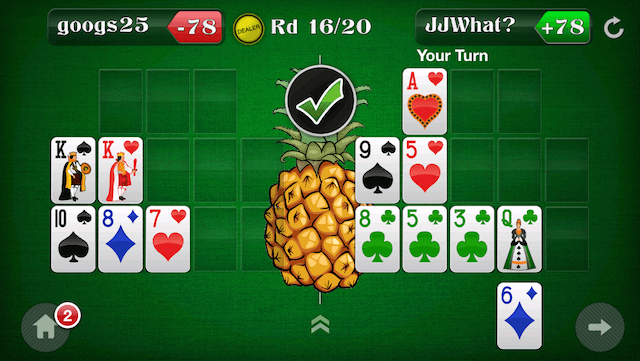
Get all the latest PokerNews updates on your social media outlets. Follow us on Twitter and find us on both Facebook and Google+!

